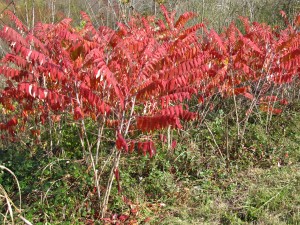Staghorn sumac (Rhus typhina) is known by several names, including velvet sumac and hairy sumac. This large shrub or small tree is native to northeastern U.S. and eastern Canada (USDA hardiness zones 3-8). Staghorn sumac often arrives uninvited into a landscape and its aggressive suckering root system makes it difficult to eradicate. For landscape use it should be limited to large properties with space for it to spread naturally.
Staghorn sumacs are noted their greenish yellow flowers in early summer and persistent red fruit clusters (drupes) in the fall and winter months. Its excellent scarlet red fall foliage color rarely disappoints. Plant in full sun for best color, but will cope in any light. Bright green pinnate leaves and reddish-brown fuzzy stems make sumacs easy to id along any road at high speeds. Male and female flowers occur on separate plants (dioecious).
Staghorn sumac grows 15 to 25 feet high and 15-20 feet wide. A pinnately compound leaf may be up to 24 inches long, comprised of 13 to 27 long narrow leaflets. Leaflets are bright green with serrated margins and glossy underside. The deep red hairy drupe fruits attract many kinds of winter feeding birds and other wildlife.
In winter young leafless stems appear club-like, covered with a dusty pubescence. As branches and trunks age, they shed their pubescence and become smooth and shiny. Prominent C-shaped leaf scars are characteristic over the winter branches, each containing an orange bud in the middle.
Rabbits and deer leave sumacs alone. Established plants are heat and drought and prosper in air-polluted urban environments and shallow rocky soil. Untended plants colonize to form a thicket from underground root suckers and seed dispersal. Roots mat in for erosion control. Disease and pest problems rarely happen when planted in open areas.


 Posted in
Posted in 
